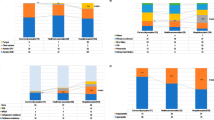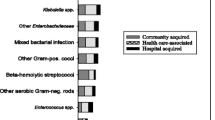Abstract
We performed a population-based study to examine the influence of healthcare-associated acquisition on pathogen distribution, antimicrobial resistance, short- and long-term mortality of community-onset Gram-negative bloodstream infections (BSI). We identified 733 unique patients with community-onset Gram-negative BSI (306 healthcare-associated and 427 community-acquired) among Olmsted County, Minnesota, residents from 1 January 1998 to 31 December 2007. Multivariate logistic regression was used to examine the association between healthcare-associated acquisition and microbiological etiology and antimicrobial resistance. Multivariate Cox proportional hazards regression was used to evaluate the influence of the site of acquisition on mortality. Healthcare-associated acquisition was predictive of Pseudomonas aeruginosa (odds ratio [OR] 3.14, 95% confidence intervals [CI]: 1.59–6.57) and the group of Enterobacter, Citrobacter, and Serratia species (OR 2.23, 95% CI: 1.21–4.21) as causative pathogens of community-onset Gram-negative BSI. Healthcare-associated acquisition was also predictive of fluoroquinolone resistance among community-onset Gram-negative bloodstream isolates (OR 2.27, 95% CI: 1.18–4.53). Healthcare-associated acquisition of BSI was independently associated with higher 28-day (hazard ratio [HR] 3.73, 95% CI: 2.13–6.93) and 1-year mortality (HR 3.60, 95% CI: 2.57–5.15). Because of differences in pathogen distribution, antimicrobial resistance, and outcomes between healthcare-associated and community-acquired Gram-negative BSI, identification of patients with healthcare-associated acquisition of BSI is essential to optimize empiric antimicrobial therapy.




Similar content being viewed by others
References
Garner JS, Jarvis WR, Emori TG, Horan TC, Hughes JM (1988) CDC definitions for nosocomial infections, 1988. Am J Infect Control 16:128–140
Friedman ND, Kaye KS, Stout JE, McGarry SA, Trivette SL, Briggs JP et al (2002) Health care-associated bloodstream infections in adults: a reason to change the accepted definition of community-acquired infections. Ann Intern Med 137:791–797
Shorr AF, Tabak YP, Killian AD, Gupta V, Liu LZ, Kollef MH (2006) Healthcare-associated bloodstream infection: a distinct entity? Insights from a large U.S. database. Crit Care Med 34:2588–2595
Marschall J, Fraser VJ, Doherty J, Warren DK (2009) Between community and hospital: healthcare-associated Gram-negative bacteremia among hospitalized patients. Infect Control Hosp Epidemiol 30:1050–1056
Olesen B, Kolmos HJ, Orskov F, Orskov I (1995) A comparative study of nosocomial and community-acquired strains of Escherichia coli causing bacteraemia in a Danish University Hospital. J Hosp Infect 31:295–304
Kang CI, Kim SH, Bang JW, Kim HB, Kim NJ, Kim EC et al (2006) Community-acquired versus nosocomial Klebsiella pneumoniae bacteremia: clinical features, treatment outcomes, and clinical implication of antimicrobial resistance. J Korean Med Sci 21:816–822
US Census Bureau. Olmsted County QuickFacts, http://quickfacts.census.gov. Accessed 21 April 2008
Melton LJ 3rd (1996) History of the Rochester Epidemiology Project. Mayo Clin Proc 71:266–274
Steckelberg JM, Melton LJ 3rd, Ilstrup DM, Rouse MS, Wilson WR (1990) Influence of referral bias on the apparent clinical spectrum of infective endocarditis. Am J Med 88:582–588
Tleyjeh IM, Steckelberg JM, Murad HS, Anavekar NS, Ghomrawi HM, Mirzoyev Z et al (2005) Temporal trends in infective endocarditis: a population-based study in Olmsted County, Minnesota. JAMA 293:3022–3028
Al-Hasan MN, Wilson JW, Lahr BD, Eckel-Passow JE, Baddour LM (2008) Incidence of Pseudomonas aeruginosa bacteremia: a population-based study. Am J Med 121:702–708
Pfaller MA, Jones RN, Marshall SA, Coffman SL, Hollis RJ, Edmond MB et al (1997) Inducible AmpC beta-lactamase producing gram-negative bacilli from blood stream infections: frequency, antimicrobial susceptibility, and molecular epidemiology in a national surveillance program (SCOPE). Diagn Microbiol Infect Dis 28:211–219
Uslan DZ, Crane SJ, Steckelberg JM, Cockerill FR 3rd, St Sauver JL, Wilson WR et al (2007) Age- and sex-associated trends in bloodstream infection: a population-based study in Olmsted County, Minnesota. Arch Intern Med 167:834–839
Al-Hasan MN, Eckel-Passow JE, Baddour LM (2010) Recurrent gram-negative bloodstream infection: a 10-year population-based cohort study. J Infect 61:28–33
Al-Hasan MN, Eckel-Passow JE, Baddour LM (2011) Influence of referral bias on the clinical characteristics of patients with Gram-negative bloodstream infection. Epidemiol Infect. doi:10.1017/s09502688100001x
Kang CI, Kim SH, Park WB, Lee KD, Kim HB, Kim EC et al (2005) Bloodstream infections caused by antibiotic-resistant gram-negative bacilli: risk factors for mortality and impact of inappropriate initial antimicrobial therapy on outcome. Antimicrob Agents Chemother 49:760–766
Schechner V, Nobre V, Kaye KS, Leshno M, Giladi M, Rohner P et al (2009) Gram-negative bacteremia upon hospital admission: when should Pseudomonas aeruginosa be suspected? Clin Infect Dis 48:580–586
Cheong HS, Kang CI, Wi YM, Kim ES, Lee JS, Ko KS et al (2008) Clinical significance and predictors of community-onset Pseudomonas aeruginosa bacteremia. Am J Med 121:709–714
Jacoby GA (2009) AmpC beta-lactamases. Clin Microbiol Rev 22:161–182
Chow JW, Fine MJ, Shlaes DM, Quinn JP, Hooper DC, Johnson MP et al (1991) Enterobacter bacteremia: clinical features and emergence of antibiotic resistance during therapy. Ann Intern Med 115:585–590
Kaye KS, Cosgrove S, Harris A, Eliopoulos GM, Carmeli Y (2001) Risk factors for emergence of resistance to broad-spectrum cephalosporins among Enterobacter spp. Antimicrob Agents Chemother 45:2628–2630
Yang K, Guglielmo BJ (2007) Diagnosis and treatment of extended-spectrum and AmpC beta-lactamase-producing organisms. Ann Pharmacother 41:1427–1435
Rodriguez-Bano J, de Cueto M, Retamar P, Galvez-Acebal J (2010) Current management of bloodstream infections. Expert Rev Anti Infect Ther 8:815–829
Sun HY, Chen SY, Chang SC, Pan SC, Su CP, Chen YC (2006) Community-onset Escherichia coli and Klebsiella pneumoniae bacteremia: influence of health care exposure on antimicrobial susceptibility. Diagn Microbiol Infect Dis 55:135–141
Siegman-Igra Y, Fourer B, Orni-Wasserlauf R, Golan Y, Noy A, Schwartz D et al (2002) Reappraisal of community-acquired bacteremia: a proposal of a new classification for the spectrum of acquisition of bacteremia. Clin Infect Dis 34:1431–1439
Kollef MH, Zilberberg MD, Shorr AF et al (2011) Epidemiology, microbiology and outcomes of healthcare-associated and community-acquired bacteremia: a multicenter cohort study. J Infect 62:130–135
Arias E (2010) United States life tables, 2006. Natl Vital Stat Rep 58:1–40
Acknowledgements
The authors thank Emily Vetter and Mary Ann Butler for providing us with vital data from the microbiology laboratory databases at the Mayo Clinic, Rochester and the Olmsted Medical Center. The authors thank Susan Schrage, Susan Stotz, R.N., and all the staff at the Rochester Epidemiology Project for their administrative help and support.
Funding
The study received funding from the Small Grants Program and the Baddour Family Fund at the Mayo Clinic, Rochester, MN, USA. The funding source had no role in study design.
This work was made possible by research grant R01-AG034676 from the National Institute of Arthritis and Musculoskeletal and Skin Diseases (National Institutes of Health, US Public Health Service).
Potential conflicts of interest
MNA, JEE, and LMB: No conflict.
MNA has full access to all of the data in the study and takes responsibility for the integrity of the data and the accuracy of the data analysis.
Author information
Authors and Affiliations
Corresponding author
Rights and permissions
About this article
Cite this article
Al-Hasan, M.N., Eckel-Passow, J.E. & Baddour, L.M. Impact of healthcare-associated acquisition on community-onset Gram-negative bloodstream infection: a population-based study. Eur J Clin Microbiol Infect Dis 31, 1163–1171 (2012). https://doi.org/10.1007/s10096-011-1424-6
Received:
Accepted:
Published:
Issue Date:
DOI: https://doi.org/10.1007/s10096-011-1424-6




